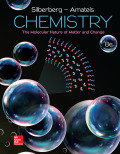
(a)
Interpretation:
For the following reaction, the percent yield of
Concept Introduction:
Equilibrium constant using partial pressure:
The equilibrium constant of partial pressure can be defined as the ratio of products and reactants concentration at equilibrium in terms of partial pressure.
For a reaction,
The expression of
(a)
Explanation of Solution
Given,
The percent yield =
(b)
Interpretation:
For the following reaction, the percent yield of
Concept Introduction:
Equilibrium constant using partial pressure:
The equilibrium constant of partial pressure can be defined as the ratio of products and reactants concentration at equilibrium in terms of partial pressure.
For a reaction,
The expression of
(b)
Explanation of Solution
Given,
The percent yield =
(c)
Interpretation:
Concept Introduction:
van’t Hoff equation gives the effect of equilibrium constant by change in temperature.
The van’t Hoff equation is given as
(c)
Explanation of Solution
Want to see more full solutions like this?
Chapter 17 Solutions
EBK CHEMISTRY: THE MOLECULAR NATURE OF
 ChemistryChemistryISBN:9781305957404Author:Steven S. Zumdahl, Susan A. Zumdahl, Donald J. DeCostePublisher:Cengage Learning
ChemistryChemistryISBN:9781305957404Author:Steven S. Zumdahl, Susan A. Zumdahl, Donald J. DeCostePublisher:Cengage Learning ChemistryChemistryISBN:9781259911156Author:Raymond Chang Dr., Jason Overby ProfessorPublisher:McGraw-Hill Education
ChemistryChemistryISBN:9781259911156Author:Raymond Chang Dr., Jason Overby ProfessorPublisher:McGraw-Hill Education Principles of Instrumental AnalysisChemistryISBN:9781305577213Author:Douglas A. Skoog, F. James Holler, Stanley R. CrouchPublisher:Cengage Learning
Principles of Instrumental AnalysisChemistryISBN:9781305577213Author:Douglas A. Skoog, F. James Holler, Stanley R. CrouchPublisher:Cengage Learning Organic ChemistryChemistryISBN:9780078021558Author:Janice Gorzynski Smith Dr.Publisher:McGraw-Hill Education
Organic ChemistryChemistryISBN:9780078021558Author:Janice Gorzynski Smith Dr.Publisher:McGraw-Hill Education Chemistry: Principles and ReactionsChemistryISBN:9781305079373Author:William L. Masterton, Cecile N. HurleyPublisher:Cengage Learning
Chemistry: Principles and ReactionsChemistryISBN:9781305079373Author:William L. Masterton, Cecile N. HurleyPublisher:Cengage Learning Elementary Principles of Chemical Processes, Bind...ChemistryISBN:9781118431221Author:Richard M. Felder, Ronald W. Rousseau, Lisa G. BullardPublisher:WILEY
Elementary Principles of Chemical Processes, Bind...ChemistryISBN:9781118431221Author:Richard M. Felder, Ronald W. Rousseau, Lisa G. BullardPublisher:WILEY





